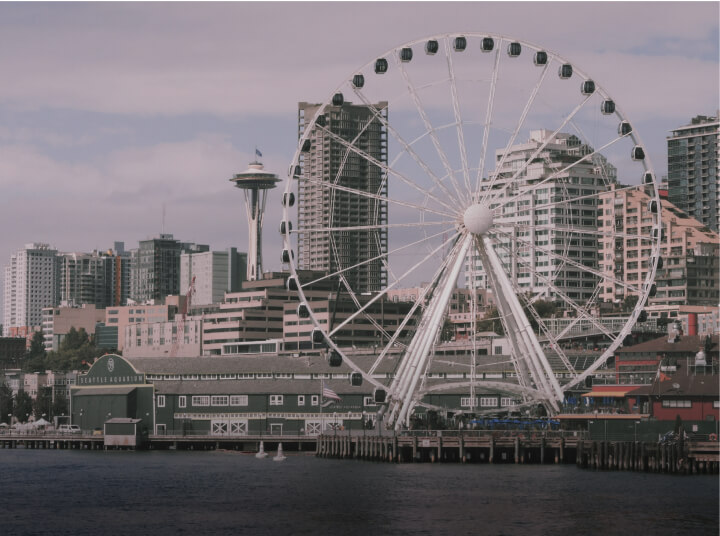interested in other markets?
Alongside the Vancouver edition of the rennie landscape, our intelligence group also produces editions for the Victoria and Kelowna markets. Read them at the links below.
table of contents
01. economy
an anchor in the storm
If the economic landscape in the United States has been defined by “uncertainty” over the past few months, there is at least one part of it offering safe harbor: the labor market, which has been unambiguously healthy.
Across the board, labor metrics have held firm and remain tighter than long-run averages. The standard (U3) unemployment rate was at 4.2% in March, meaningfully below the decade average of 4.7%. Job creation has been robust; annual wage growth remains strong; levels of layoffs are low despite various news headlines indicating otherwise; and the average quits rate is high, suggesting workers still have confidence in finding another job.
Much of this strength can be traced to consumer spending, which has been steady thanks to American households having exited the pandemic lockdown with strong balance sheets. Consumers paid down debt or accumulated savings during this period and are now driving demand, which is in turn bolstering business performance across sectors.
But it’s not all smooth sailing, and there are signs of softening both in the past year and in the outlook ahead. In each of the aforementioned metrics, 2025 values were healthier than the historical norm, but also less positive than this time last year. Indeed, labor markets have seen a slow but steady deterioration since they recovered post-pandemic in 2022.
But the real test may lie in the months ahead, as fallout from trade tensions begins to show up in the data. The cadence of new developments in the trade war is near-daily and changing too fast to be comprehensively detailed here. But whether the tariffs are here to stay or turn out to be a bargaining tactic (as some optimists hope), their impacts are already very real, as we’ll detail in later sections.
Amid difficult economic times, the labor market has been an enduring source of reassurance. There are warning signs ahead, however, and trade wars will test its true resilience.
FAIR WEATHER FOR NOW
DATA: SELECT UNEMPLOYMENT RATES, ANNUAL WAGE GROWTH, NONFARM QUITS RATE, UNITED STATES
SOURCE: BUREAU OF LABOR STATISTICS
mildly hot
US job creation numbers have been heated for years, buoying the economy. While today’s numbers remain elevated, they fall short of the previous peak.
A great way to gain additional insight into the labor market’s strength is to look at changes in total employment. A strong rise in employment levels means that businesses are confident enough to hire, and that the economy is generating enough new opportunities to absorb a growing population.
Economists estimate that the “neutral” rate of job creation in the US—the number of net new jobs required to keep the unemployment rate steady—is about 100,000 per month. But from 2022 to 2024, the US has pushed well past this pace, adding an average of 283,000 nonfarm jobs per month—for a total of 4.5 million additional jobs over the expected neutral level during that period. By contrast, since the beginning of last year, that average has fallen to 167,000 jobs added per month. That’s still 67% above the neutral rate, but it paints a clear picture of a peak hiring period that’s now cooling off.
GROWTH, DIALED BACK
DATA: CHANGE IN TOTAL NONFARM EMPLOYMENT, MONTHLY, 2022-2025, UNITED STATES
SOURCE: BUREAU OF LABOR STATISTICS
earning our way out
We're three years into our battle against inflation, and still it remains above target. But increases in prices are only one side of the affordability equation; and the other side offers comfort.
At its peak, headline inflation held at annualized rates of above 8% for nearly a year, driving the cost of everyday goods and services up at a pace that was difficult for many to manage.
But inflation is just the ongoing rate at which things become more expensive. To get an intuitive understanding of its total impact so far, we need to look at the cumulative change in the Consumer Price Index (CPI). Since January 2022, the index is up 21.7%—meaning on average, consumers are spending over 20% more for the same goods and services in just three years.
But there is one important silver lining here: as costs have gone up, so have average earnings. As discussed earlier, wage growth has been strong and, since mid-2023, has actually outpaced inflation. This means that while inflation remains above target, its worst effects on consumers are now being meaningfully mitigated.
KEEPING PACE WITH THE PACE OF CHANGE
SOURCE: BUREAU OF LABOR STATISTICS
DATA: HEADLINE CPI AND AVERAGE HOURLY EARNINGS WAGE GROWTH, ANNUALIZED, MONTHLY, 2022-2025, UNITED STATES
false confidence
From consumers to business leaders, anxiety is seeping into markets. Whether the fears turn out to be warranted or not, real damage is already being done.
Economists often keep close track of sentiment surveys, and for good reason. Feelings about the economy have a way of actually shaping reality. When business leaders grow pessimistic, for example, they naturally pull back on expansion plans, think twice about new hires, or even revisit existing headcount. Similarly, households facing uncertainty tend to delay major purchases, reduce discretionary spending, and build precautionary savings rather than circulate money through the economy. Sentiment ripples through decisions until they manifest as the very economic conditions everyone feared.
Confidence indices have historically tracked closely with developments in markets.
When inflation hit a multi-year low in September 2024, confidence immediately began to climb; as the first hints of the looming trade war began with tariff threats in November 2024, confidence just as quickly began to deteriorate. But the recent declines have been particularly pronounced, reflecting the growing concerns over what a protracted trade war means for economic growth and for the fight against inflation.
The Conference Board’s Consumer Confidence Index is now at its lowest level in four years; the University of Michigan’s index just posted its second-lowest reading since 1952, with only June 2022 (during the period of peak inflation) coming in lower; and while small business optimism remains relatively strong, it too has taken a significant hit in recent months.
Although this anxiety in markets is showing up in sentiment surveys first, we can fully expect its impact to other metrics to be apparent by the next edition of this report.
(NOT SO) GREAT EXPECTATIONS
DATA: SELECT CONFIDENCE INDICES, ALL INDEXED TO JANUARY 2024
SOURCE: UNIVERSITY OF MICHIGAN SURVEY RESEARCH CENTER, THE CONFERENCE BOARD, NATIONAL FEDERATION OF INDEPENDENT BUSINESS (NFIB)
warning lights ahead
The Federal Reserve’s preferred recession indicator is flashing, and its track record is compelling.
In bond markets, long-term treasuries typically offer higher returns than short-term ones to compensate investors for the extended commitment and added risk. The difference between these two returns is known as the spread, which is usually positive. But when the economic outlook becomes clouded, this relationship can flip, creating a negative spread where short-term yields exceed long-term ones.
There's one version of this spread that's closely monitored by the Federal Reserve as a recession indicator: the 10-year vs 3-month treasuries. Prior to 2021, each of the past four times this spread turned negative, a recession followed within 6-18 months. Even more telling, all US recessions in recent decades have been preceded by this particular inversion.
Now whether you were paying attention to bond markets or not, this spread has actually already spent significant time in negative territory in recent years. Yet the recession never materialized, leading many to believe we had avoided the worst where no economy had before. The explanation seemed sensible enough: the pandemic created such abnormal economic conditions that traditional indicators couldn't be trusted. But recent developments give us reason for pause. As confidence has waned, the spread has inverted once more. In a strange way, the current inversion mirrors the last—both triggered by sudden, external shocks rather than natural economic cycles. Like the pandemic, today's inversion stems from unprecedented tariff uncertainties that have few historical parallels for us to draw from.
FLASHING RED
DATA: 10-YEAR VS 3-MONTH TREASURY YIELD SPREAD, 1985-2025, UNITED STATES
DATA: 10-YEAR VS 3-MONTH TREASURY YIELD SPREAD, 1985-2025, UNITED STATES
subscribe to real estate insights that matter
Real estate insights, analysis and perspective from our rennie intelligence division—helping you make sense of Seattle’s market.
By submitting your personal information, you consent to receive electronic messages from rennie marketing systems, including newsletters and event invitations. You can withdraw your consent at any time by following the unsubscribe link in any message. You can also refer to rennie’s privacy policy for more information and contact details.
copyright © 2025 rennie all rights reserved
rennie group
By using this website, you agree to our Privacy Policy and Terms of Use.
do not share or sell my personal information
California DRE #02248150

























